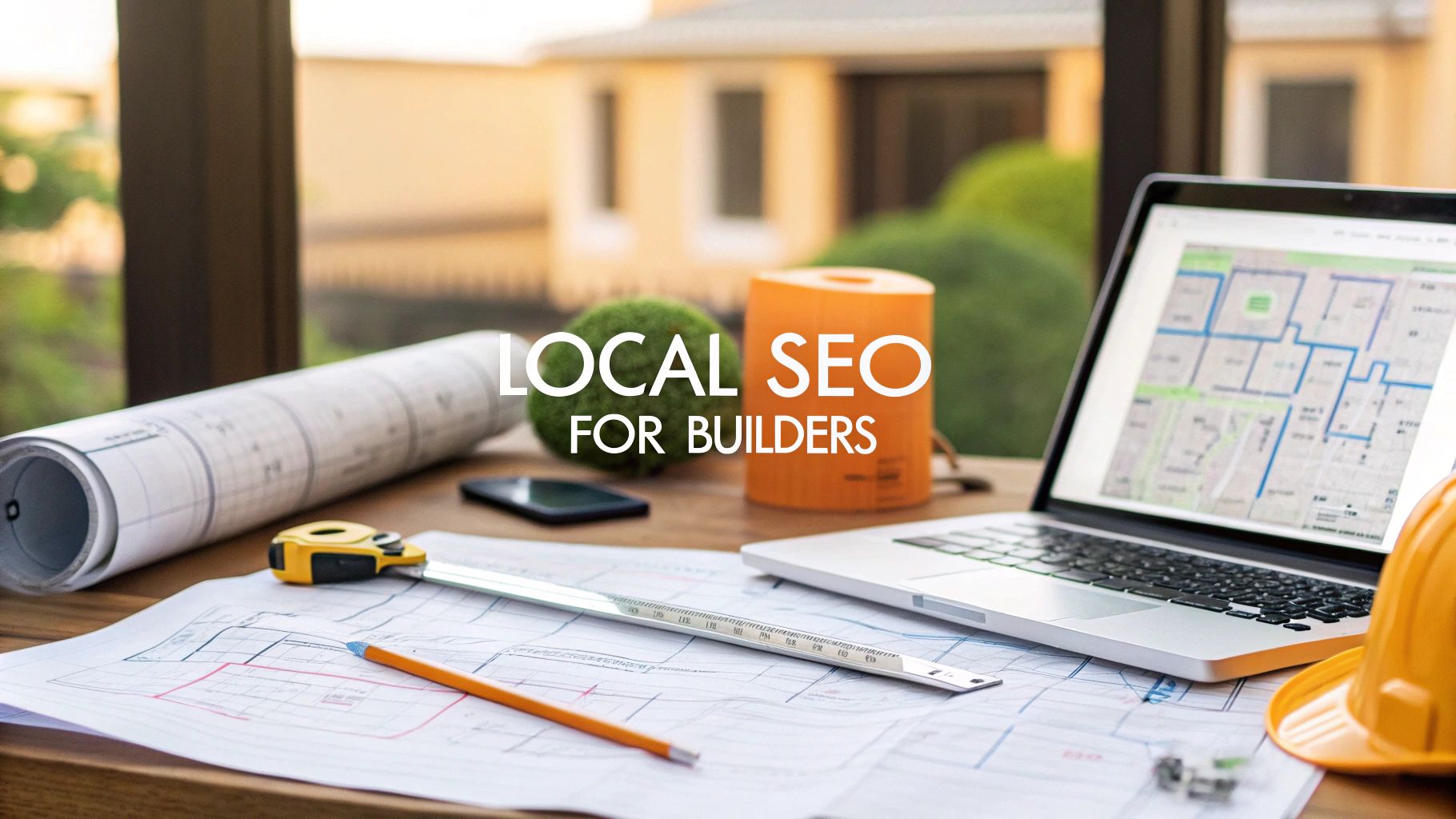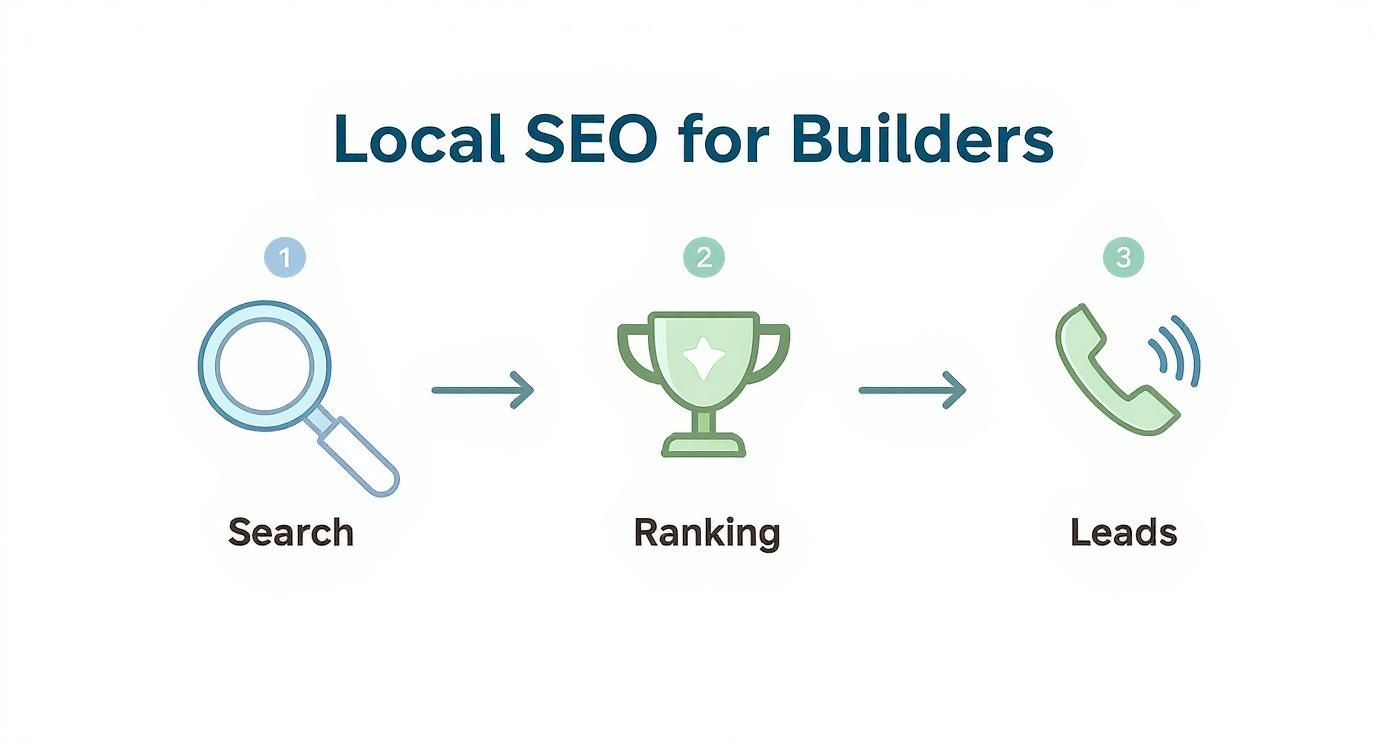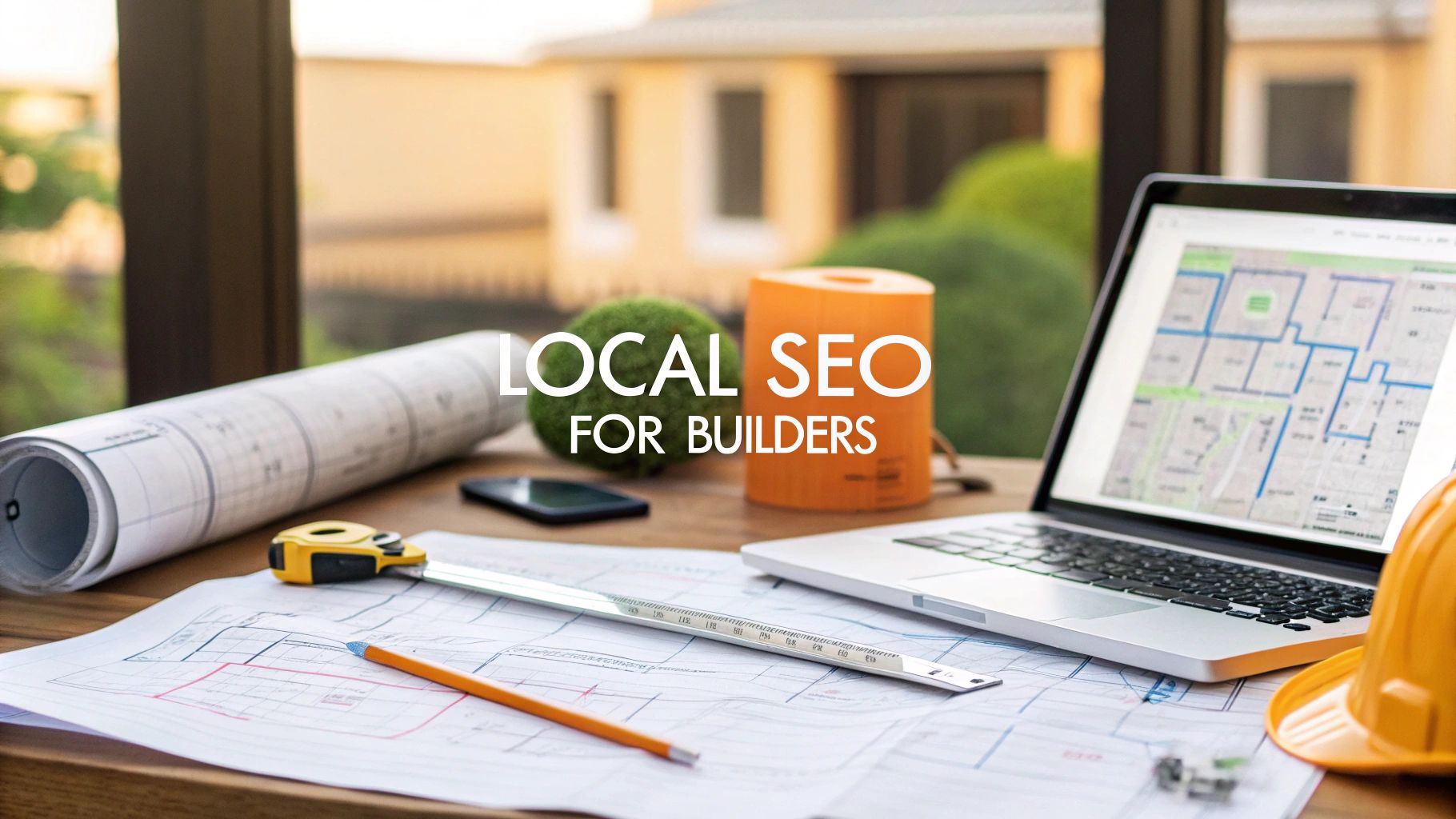


Local SEO for builders is about making your business easy to find when people in your area search online for your skills. When someone types "home builder near me" or "renovation specialist in Tauranga" into Google, you want to be the first name they see. It’s about channelling high-quality, local leads straight to your phone.
Forget dropping a fortune on old-school marketing with fuzzy results. Today, your next big job will almost certainly start with a Google search.
When a homeowner needs a trusted builder for a new build in Queenstown or a major renovation in Auckland, they don't pull out the Yellow Pages. They pull out their phone. They’re looking for proof of quality work, genuine local expertise, and a professional they can trust. This is where local SEO gets you in the door.
It's the modern version of a word-of-mouth referral, just scaled up. Instead of one happy client telling their neighbour about you, you’re setting your business up to be recommended by Google to hundreds of potential clients in your specific patch.
The goal is simple: make your building company the obvious, trusted choice for anyone searching locally. This isn't about digital wizardry; it's about showing up where your customers are already looking.
Good local SEO isn’t about casting a wide, hopeful net. It’s a targeted approach that cuts through the noise and puts you in front of homeowners who are actively looking to hire someone.
They’re using specific search terms that show they're serious, like "best residential builder in Ponsonby" or "kitchen renovation costs Wellington." By optimising your online presence for these exact local searches, you make sure you’re right there the moment a client is ready to make a call.
This gives you a direct line to motivated customers, which means less time wasted on cold leads and more time quoting on profitable work. You'll build a pipeline of solid enquiries from people who have already seen your projects, read your reviews, and decided you might be the right builder for them. This isn't just marketing—it's a smart system for generating better business.
Plenty of builders across New Zealand are already getting onto this. In fact, around 40% of NZ businesses have started using AI tools to help with their SEO content, a huge sign of how things are shifting online. It lets them create targeted content that reaches local clients without wasting time.
You can dig into more of these insights on New Zealand SEO trends. Getting your local SEO sorted means you’re not just keeping up with the competition; you’re building a lasting asset for your business that brings in consistent work, month after month.
Think of your Google Business Profile (GBP) as the digital front door to your building company. It’s often the first impression a potential client gets. It’s not just a listing; it’s a powerful tool for winning work before they even see your website.
Getting this right is non-negotiable if you're serious about local SEO. When a homeowner in Tauranga searches "new home builder," Google's first reflex is to show them the local map pack. Being in that top three is like having a billboard on the busiest street in town—it puts you directly in front of motivated customers.
The process is simple: a local search leads to your high ranking, which turns into direct leads for your business.

The flow is obvious—visibility gets you seen, ranking builds your authority, and the result is more phone calls and quote requests. Simple.
First, you need to tell Google exactly what you do. Don’t just list "Builder" as your primary category and call it a day. Be specific. If you specialise in high-end architectural homes, choose a category that reflects that.
From there, get granular with the services you offer. This is how you attract the right kind of jobs. Think about what a client would actually search for.
Getting these details right means you show up in searches that actually matter. A client searching for a "kitchen remodelling specialist" is far more likely to find you if that's an exact service you've listed. It’s all about matching your expertise to their need.
Next, tell Google precisely where you work. A common mistake is builders just listing their main city. Don't do that. Instead, define your service area by listing all the suburbs and towns you cover.
If you’re based in Christchurch but also work in Rangiora, Kaiapoi, and Rolleston, add them all to your profile. This helps you appear in searches like "builder in Rolleston" even if your physical address is elsewhere. This single action dramatically expands your digital footprint, making you visible to a much wider pool of ideal clients.
Your Google Business Profile isn't a passive listing. It's an active lead-generation machine. The more accurate and detailed the information, the harder it works for you.
Photos are your proof. A profile with no images—or worse, just a logo—looks unprofessional and untrustworthy. Homeowners want to see the quality of your craftsmanship before they pick up the phone.
Upload crisp, high-resolution photos of your best finished projects. Show off the clean joinery in a kitchen reno or the impressive framing of a new build on the coast. These are the images that stop people from scrolling and immediately build confidence in your ability to deliver.
To help you get this right, here’s a quick checklist. It covers the essentials for making sure your profile is a magnet for local clients.
Ticking off every item on this list will put you miles ahead of most of your competitors.
Every photo, service, and detail you add reinforces your professionalism and expertise. For more inspiration on how leading Kiwi companies are making their mark online, check out our Onsite Media New Zealand project showcase. A strong GBP is the foundation of a standout digital presence. It's your digital handshake—make sure it’s a firm one.
Your Google Business Profile is the introduction, but your website is where you close the deal. It needs to be your hardest-working salesperson—on the clock 24/7, turning browsers into solid leads.
A slick-looking website is great, but a site strategically built to pull in local clients is what actually fills your project pipeline. The mission is simple: when a homeowner lands on your site, they need to feel certain you’re the right builder and see a dead-simple way to get in touch.
This means your website has to be more than a glossy online brochure. It needs a structure that answers the exact questions local customers are asking, showing off your expertise and building trust from the first click.

Generic, one-size-fits-all content doesn’t land anymore. To attract the projects you want, your website has to speak the language of your ideal clients in the areas you service. This starts by creating dedicated pages for your core services and the suburbs you work in.
Put yourself in the client's shoes. Someone in Ponsonby isn't just Googling "builder." They're searching for "Ponsonby architectural build" or "Herne Bay renovation specialist." Building specific pages that match these searches is how you get found.
Here’s a smart way to structure your site to capture this local intent:
This structure does two things brilliantly. First, it sends a clear signal to Google about what you do and where you do it, making you more relevant in local search results. Second, it shows potential clients you know their neighbourhood, which is a massive shortcut to building trust.
Your website content needs to do more than list what you offer. It needs to proactively answer the real-world questions and concerns homeowners have long before they pick up the phone. This move instantly positions you as a helpful expert, not just another contractor bidding for a job.
To grab the attention of local clients, it’s vital to dig into localized keyword research strategies. This is how you uncover the exact phrases people are typing into Google when they need a builder.
Once you know what they're asking, you can create content that gives them genuine answers.
A website that answers a client's questions before they ask them doesn't just generate leads; it generates informed, confident leads who are ready to move forward.
This could be a blog post about navigating the building consent process in Auckland, or an article discussing the best material choices for coastal builds in the Bay of Plenty. This is the kind of practical, valuable content that works. For a much deeper dive into creating content that truly connects, check out our guide on builder content creation.
All this hard work goes to waste if a potential client lands on your site and can't immediately figure out how to contact you. Your website must have unmissable, compelling calls-to-action (CTAs) that guide every visitor towards getting in touch.
Don't make them hunt for it. Your phone number needs to be front and centre on every single page. Your contact form needs to be quick and painless.
Here are a few practical tweaks that make a huge difference:
By dialling in your site's structure, content, and calls-to-action, you’ll transform it from a static portfolio into a powerful machine for winning local work.
In the building trade, your reputation is everything. On-site, you build it with quality work and your word. Online, that same reputation comes down to two things: glowing client reviews and a killer portfolio of your best projects.
From a potential client's perspective, when they find you on Google, they’re not just looking for a name and number; they’re looking for proof. They need to see that you’re not only capable but that other homeowners in their area trust you completely. This is how you go from just being found online to actively converting that visibility into high-quality leads.
Online reviews are today's word-of-mouth. A constant stream of positive feedback on your Google Business Profile is a massive trust signal for both potential customers and Google's algorithm. The numbers don't lie: a whopping 98% of consumers read online reviews for local businesses.
Getting those reviews doesn't have to be an awkward process. It’s all about weaving a simple, repeatable step into the end of every successful project.
The secret is to ask when the client is at their happiest—usually during the final walkthrough when they’re buzzing about their new space. Don’t wait a week and send a generic email. Make the ask personal and, most importantly, make it dead simple for them.
A simple, direct link to your Google review page removes all friction. The easier you make it for a happy client to leave feedback, the more likely they are to do it.
Responding to every single review is just as crucial. A quick, "Thanks, Sarah, it was a pleasure bringing your vision to life!" shows you’re engaged and you appreciate their business. For future clients scrolling through, it shows you value relationships, building another layer of trust before they’ve even picked up the phone.
Words build trust, but photos prove your craftsmanship. In a visual trade like building, high-quality images of your work are non-negotiable. They are what stops a potential client from scrolling and gives them an instant, tangible feel for the quality you deliver.
This isn’t about snapping a few quick pictures on your phone as you're packing up the tools. This is about strategically showcasing your projects in the best possible light to attract the high-value jobs you want.

Here's what to focus on for photos that win work:
Investing in a professional photographer will pay for itself many times over. It helps you attract better clients and justifies a higher price point because it’s a direct reflection of your professionalism. If you're serious about creating a standout portfolio, understanding the basics of architectural photography is a genuine game-changer. It’s about capturing not just the structure, but the feeling of a space.
By combining a solid review strategy with a stunning visual portfolio, you create a powerful one-two punch. You're not just telling people you're a great builder; you're showing them, backed by the trusted voices of your past clients. This is how you turn a curious browser into a confident lead who is ready to build.
This next part of local SEO might sound technical, but the idea is pure common sense. It’s all about building digital proof that you’re a legitimate, respected builder in your area.
Think of it like this: when other trusted businesses mention your company online, it’s a powerful endorsement. Google sees these mentions and thinks, "Okay, this builder is a real player. Others in the industry vouch for them." This builds your website's authority, which in turn boosts your rankings and brings in more qualified leads.
We’ll focus on two key types of online endorsements: local citations and backlinks. Nailing these is a straightforward way to strengthen your digital reputation and show both Google and potential clients that you're a trusted name in the building trade.
A local citation is simply a mention of your business Name, Address, and Phone number (often called NAP) on another website. The most common place you'll find these is on online directories. For Kiwi builders, getting listed on industry-specific sites is a crucial first step.
These citations are like digital signposts pointing back to your business. The more consistent and accurate these signposts are, the more confident Google becomes in recommending you. Consistency is critical: your details must be identical everywhere.
Here are some of the key NZ-based directories where you need to be listed:
Getting your business listed accurately on these core directories isn't just a box-ticking exercise. It's about laying a solid foundation of trust that makes all your other local SEO efforts far more effective.
While citations are mentions, backlinks are actual, clickable links from another website to yours. Think of a backlink as a direct referral. When another reputable site links to your website, it's passing some of its authority and credibility to you. A single high-quality backlink can often be more powerful than dozens of directory listings.
But where do you get these valuable links? This isn't about begging or buying them. It’s about building real-world relationships that translate into online credibility.
For a builder, the best backlinks come from the local businesses you already work with. This is a practical strategy that leverages your existing network to strengthen your online presence.
Here are a few ideas to get you started:
Your Suppliers: Have a great relationship with your local PlaceMakers or Mitre 10? Ask if they have a "featured builders" or "partners" section on their website where they could link to your portfolio. You’re bringing them consistent business; a link is a simple way for them to return the favour.
Your Subcontractors: The sparkies, plumbers, and architects you work with on every project are perfect partners. Suggest a content swap—you could feature their work in a project case study on your site and ask them to do the same for you, with a link back to your homepage.
Local Community Involvement: If you sponsor a local rugby team or support a community event, make sure part of that sponsorship includes a link from their website back to yours. This not only builds local goodwill but also creates a powerful local signal for your SEO.
By strategically building these citations and backlinks, you’re creating a web of trust around your business. This tells Google you’re a central part of the local building industry, making it much easier for your ideal clients to find you when they're ready to start their project.
You wouldn't build a house without a set of plans and a tape measure. The same goes for your marketing. You can't improve what you don't track. Getting your local SEO sorted is a great first step, but the real power comes from seeing exactly what's working so you can double down on it.
This isn't about getting bogged down in confusing charts or chasing "vanity metrics" that do nothing for your bottom line. It’s about focusing on a few key numbers that tell you one thing: whether your online efforts are actually bringing in more work.
The best part? You don’t need any expensive software. The essential tools are completely free and give you everything you need to make smarter decisions.
Let's cut through the noise. There are only two tools you really need to get started with tracking your local SEO performance: Google Search Console and Google Analytics. Think of them as your digital level and square—fundamental for getting the job done right.
Setting them up is straightforward, and the insights they provide are pure gold for understanding how potential clients find you online.
Once your tools are running, ignore the flood of data and laser-focus on what directly impacts your lead pipeline. Chasing "clicks" or "impressions" is a waste of time if those visitors aren't turning into actual quote requests.
Here are the numbers that should be on your radar:
Tracking these core metrics gives you a clear, honest picture of your return on investment. It turns your marketing from a guessing game into a calculated strategy for winning more profitable jobs.
To make sure your local SEO efforts are truly paying off, you need to connect the dots. Explore proven strategies to measure marketing ROI and demonstrate real business growth. It’s all about tying every action back to tangible outcomes—more calls, more quotes, and a fuller project schedule.
Even with a solid game plan, you're bound to have questions about how local SEO actually works for a building company. Here are some straight-up, no-fluff answers to the questions we hear most often.
The million-dollar question. You can see early movement in local map rankings within 3-4 months of consistent work. That's usually the result of getting your Google Business Profile properly sorted and cleaning up any messy data.
But that’s just the beginning.
To really start ranking for those high-value keywords that bring in the good jobs—like "architectural builder Auckland" or "home renovations Tauranga"—you need to play the long game. Building real authority takes time, typically 6-12 months, as you gather more client reviews, earn local business listings, and regularly add quality project content to your website.
Think of local SEO as a long-term investment in your business, not a quick advertising fix. The results compound, delivering more value the longer you stick with it.
A blog isn’t a must-have for every single builder, but it's a powerful tool if you use it right. Don't think of it as "writing articles"—think of it as creating a library of proof that you're the expert.
It's the perfect spot to showcase detailed project case studies. Imagine a write-up on a recent "Coastal Renovation in Mount Maunganui" that walks potential clients through your process and highlights the finished craftsmanship.
It’s also your chance to answer the questions your clients are already asking, like "What’s the building consent process like in Queenstown?" This kind of content doesn't just help you rank for more specific search terms; it builds a massive amount of trust before they even pick up the phone. You’re not just another builder; you’re the authority.
This isn’t the right way to think about it. They aren’t competing against each other. They’re a team, and you need both to win.
You need both firing on all cylinders. A great GBP gets you found, but a professional, convincing website is what turns that interest into a real job. If you neglect one, you're just hamstringing the other.
Ready to stop being the best-kept secret in your local area? The team at Onsite Media helps New Zealand’s best builders translate their on-site excellence into a powerful online presence that wins work. Book a no-obligation strategy call with us today.

